
This guide covers: pavement breakers, chipping hammers, diggers, rammers and tampers, large T handle pneumatic boring style motors, and rivet busters
The construction industry and its related trades require an arsenal of pneumatic tools engineered not only for productivity, but also for longevity. Tools that are well built, safe, intuitive to use, and can withstand the rigors of the modern job site.
At International Air Tool Company, we have extensive experience recommending construction style air tools designed to meet the demands of the toughest applications.
In the following guide, we provide an overview of our most popular percussive style pneumatic tools. For quick reference, we’ve divided the guide by tool type, and provided a snapshot of the key features and specifications to consider when making a buying decision.
To begin, you should understand that all percussive style air tools, regardless of the style, deliver repeated blows in a linear fashion. What varies is their size, weight, stroke length, piston diameter, blows per minute delivered, and the orientation of the operator when the tool is in use.
Another factor to consider is the shank size of the tool and the shank size of the bits to be used with it. There are many variations of shanks and chuck sizes and the bits for a chipping hammer for example will not fit in a rivet buster or digger. We will list each tool's shank and nozzle sizes later in the guide.
Let’s begin our discussion with one of the most well known and commonly used percussive tools, the pavement breaker.
Pavement Breaker Overview:
Pavement breakers (also known as paving breakers), are versatile air tools commonly used by contractors, public works departments, and utility crews. They are most often deployed to break up concrete and asphalt, but can also be used to dig or trench earth. Pavement breakers use brute force to penetrate hard materials and thus require large amounts of compressed air flow (as measured in CFM). On a side note, to ensure a sufficient flow of air to the tool, many organizations requiring a portable air source opt for the industry standard 185 CFM tow-behind compressors powered by either gasoline or diesel fuel. We have had great success powering our tools with these compressors.
The main factor to consider when choosing a pavement breaker is its weight. While the exact weight of the tool may vary by a few pounds, pavement breakers typically weigh either 45 lb., 60 lb., or 90 lbs.. Aside from the differences in weight, other distinguishing characteristics include top to bottom length
and the stroke of the tools piston. Naturally, a 90 lb. unit will be larger, hit harder, and feature a longer piston stroke than its 45 lb. and 60 lb. counterparts.
Pavement breakers are standard equipped with a T-Style handle which dictates that the tool be used in an upright position or at no more than a 45 degree angle.
Pavement breakers are also offered in an optional; low vibration, flex handle build which reduces the amount of vibration transferred to the operator’s arms.
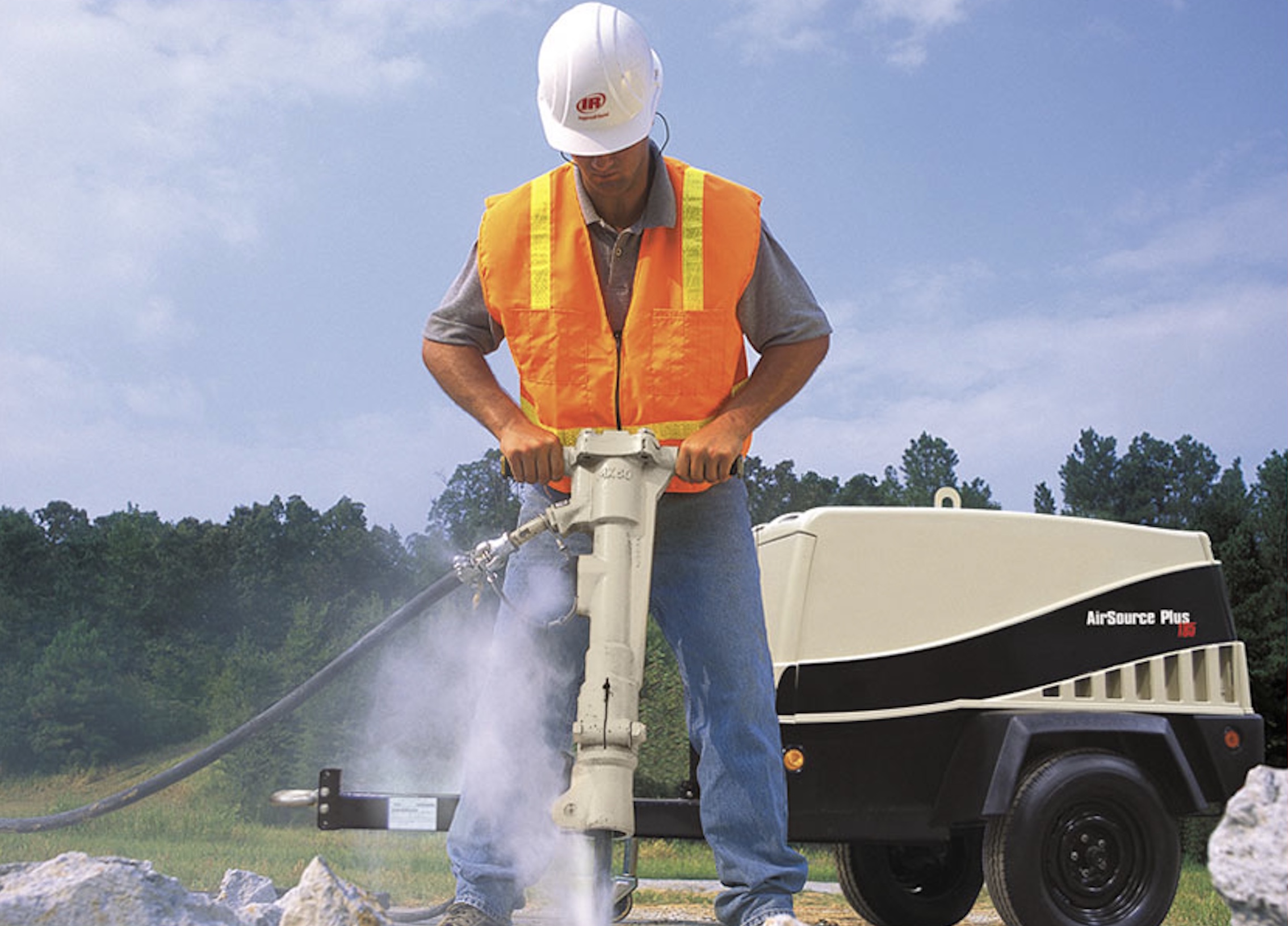
Pavement Breaker Uses and Applications:
-
General demolition on roads, floors, concrete, masonry, and frozen dirt
-
Breaking through asphalt on highway surface projects or utility & sewer maintenance
-
Exposing foundation reinforcement on construction sites
-
Removing or clearing spaces for stairs, risers or shafts
-
Creating channels in flooring to lay down piping
-
Bridge deck demolition
Key Features and Benefits:
-
Rugged 4-bolt construction
-
Powerful pistons for maximum energy transfer to the work
-
Ergonomically designed back-head, handle, grips, and throttle lever
-
Drop in valve cartridges for quick and easy maintenance (the air valve on a pavement breaker can become corroded)
-
Built in lubricators
-
Latch type retainer for fast bit changes
-
Alloy steel forgings
Additionally, Ingersoll Rand Pavement Breakers feature a one piece housing that requires 30% fewer parts and eliminates the need for rods and springs.
Common Pavement Breaker Specifications:
-
Lengths: 25” to 27.5” long
-
Blows Per Minute: 1150 to 1850 BPM depending on the size and weight of the tool (smaller tools hit faster and softer, while heavier tools hit harder and slower)
-
Air Consumption (CFM): 48 to 85 CFM - a smaller pavement breaker (30 lb. or 45 lb.) may be operated with a 15 HP compressor while a 90 lb. breaker will require an approximate 25 HP compressor.
-
Bore (Piston Diameter): 1/3/4” on the smaller tools, up to 2-⅝” piston bore on the 90 lb. models
-
Stroke Length:
-
45 lb. breaker = 3-3/8”
-
60 Lb. breaker = 4-⅛”
-
90 Lb. breaker = 6-⅛
-
Shank Sizes:
-
45 Lb. breaker = ⅞” x 3-¼” or 1” x 4-¼”
-
60 Lb. breaker = 1-⅛” x 6” or 1-¼” x 6”
-
90 Lb breaker. = 1-⅛” x 6” or 1-¼” x 6”
A wide selection of moil points and chisels are available for our pavement breakers. However, you must match the shank size of the bit you plan on using with the shank size of the tool - An ⅛” difference can cause a major safety hazard so measure correctly! Our selection of pavement breaker steels can be found here:
Ingersoll Rand Constructions Steels
Rock Drills Overview
Rock Drills differ from Pavement Breakers in that they are designed to create cylindrical holes in contrast to just demolishing materials. Rock drills are both percussive and rotary in nature. That is, they deliver downward blows while simultaneously turning in rotary fashion similar to the way a hammer drill works. Rocks drill weights and sizes range from a mini 9 lb. combination chipper-drill, to a 60 lb. model capable of drilling holes up to 12’ deep.
The actual drilling action itself is performed by a carbide tipped drill bit mounted on a drill rod whose shank gets inserted in the chuck of the rock drill. Rock drills can drill holes up to to 4” in diameter and up to 72” deep. Unlike pavement breakers, rock drills are also sometimes used on the horizontal:
Initially created by Ingersoll Rand in 1871 and used in the construction of both Mount Rushmore and Hoover Dam, Rockdrills are designed for a fairly specific set of applications.
Uses and Applications:
-
Rock and mineral excavation
-
Blast hole drilling, maintenance work, and mud jacking
Key Features and Benefits:
-
Can be used for wet or dry drilling
-
3 speed throttle for controlled precision drilling
-
Reversible pawls
-
Integrated mufflers for lower noise levels
-
Adjustable directional exhaust for operator comfort
-
Latch type bit retainer for fast accessory changes
Specifications:
-
Blows Per Minute: 2100 BPM to 2700 BPM
-
Air Consumption - 80 CFM to 120 CFM - a 25 to 40 horsepower compressor is required in order to achieve the tool’s maximum potential
-
Bore (Piston Diameter): Varied - ranges from 1” on the 10 lb. model up to 2-⅝” on a 60 lb. drill
-
Stroke Length: 1-⅜” up to 2-¾”
-
Shank Sizes:
-
10 Lb. Rock Drill: ¾” x 3-¾” Round Slotted
-
20 Lb. Rock Drill: ⅞” x 3-¼” Hex
-
40 Lb. Rock Drill: ⅞’ x 3-¼” or 4-¼” | 1“ x 4-¼” Hex
-
60 Lb. Rock Drill: ⅞’ x 3-¼” or 4-¼” | 1“ x 4-¼” Hex
-
Recommended Air Hose Diameter: ¾” (Important because like pavement breakers, rock drills draw a lot of air)
Chipping Hammers
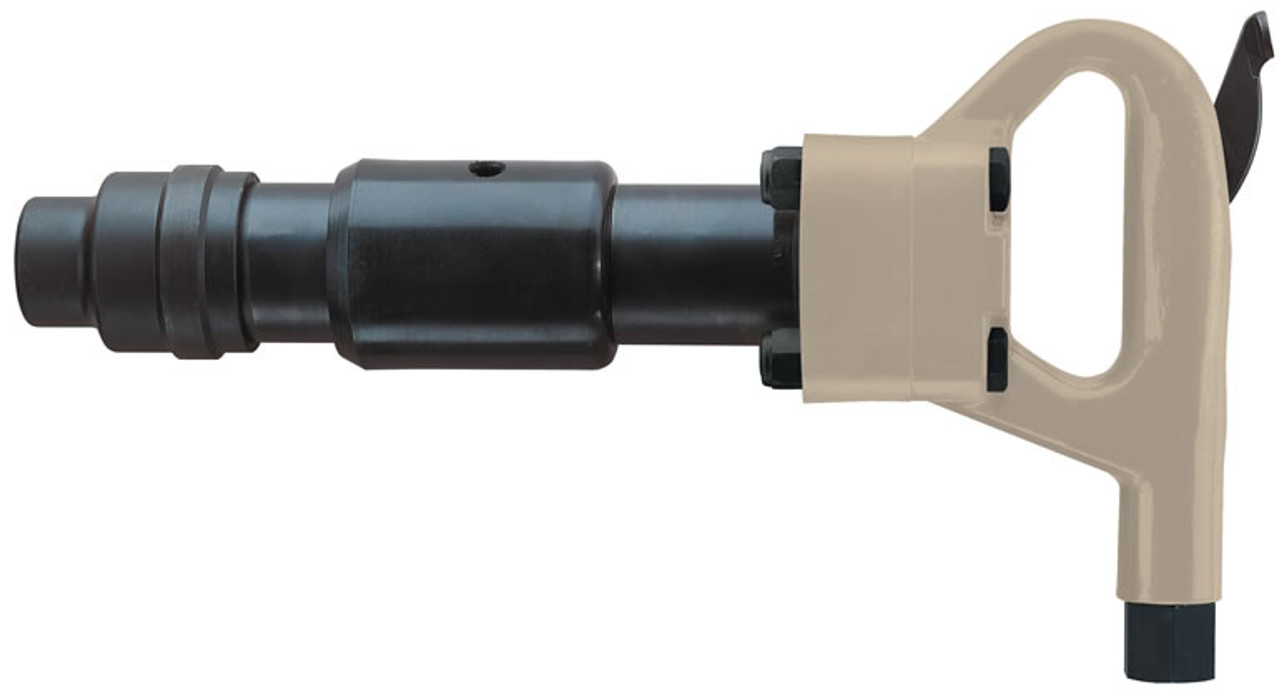
Favored by contractors and industrial users alike, pneumatic chipping hammers set the bar for general purpose demolition tools and can be found in a variety of industries worldwide. Industrial grade chipping hammers utilize engineered valving that provides both a crisp throttle response and hard hitting power. Furthermore, our chippers also feature heat treated internal components made from high quality alloy steels which ensure a long service life and reduced maintenance. Aside from being the most widely used tool for demolition, pneumatic chippers are also ergonomically designed. The D-shaped and swan neck style handles ensure the operator's hands and arms are in line with the tool’s chisel for maximum effectiveness and comfort throughout the work day.
Pneumatic Chipping Hammer Applications:
Chipping Hammers are used for light to medium duty material removal, typically in the horizontal or overhead positions. An air-driven hammer/piston drives a bit (often called a “steel”) back and forth in a reciprocating movement. Depending on the material to be worked, different stroke lengths and attachments are required. Chipping hammer stroke lengths range from 1” to 4” and their most popular accessories are moil points, narrow chisels, and wide scaling chisels. Here are some common uses for chipping guns:
-
General demolition
-
Carving rock
-
Removing grout between brick,
-
Removing plaster and other swimming pool surfaces
-
Removing dried concrete from inside cement mixers.
-
Cutting in and creating holes
-
Edge cutting
Key Features and Benefits:
-
Die cast aluminum handles with internal finger trigger or external thumb throttle
-
Available in 1”, 2”, 3”, or 4” stroke lengths
-
Available in D handle or swan neck style grips
-
Replaceable pistons
-
Directional exhaust
-
Teasing throttle action
-
Standard spring style or threaded rubber buffered retainers (model specific)
It’s important to select the right chipper for the job at hand, so here are a few quick tips for matching the tool to your work:
-
Working with soft materials - For softer materials where the goal is scaling, think low impact energy and short strokes with a high impact rate to enhance productivity (1” or 2” stroke lengths)
-
Light chipping and scaling. For this kind of work, you also need a smaller chipping gun with a high blow rate, but low impact energy (1” or 2” stroke lengths)
-
Tougher materials. To some extent, this depends on the hardness of the material and the application itself, but usually you will opt for longer stroke, higher impact tool designed to penetrate.
You can also use small or medium chipping hammers to split spot welds, plug drill holes or fettle castings in a foundry. Larger hammers can be used for concrete demolition, cleaning cement mixtures, cleaning foundry crucibles and so on. However, for heavier demolition you should move up to a Rivet Buster.
A Note On Shank and Nozzle Sizes
The nozzle of a chipping hammer is where the shank of the bit goes. Chipping hammers feature two nozzle sizes:
and
Independent of the tools nozzle, they may be equipped with either a round or oval collar style bit retainer. The collar of the bit nests inside the nose of the retainer. You must make sure that when you purchase a chipping hammer and/or bits that both the shank and collar sizes match up. Below is an example of a retainer with an oval shaped collar, therefore the bit to be used with this retainer must also have an oval collar.\
To further illustrate, here is a list of potential chipping hammer nozzle (shank) and retainer (collar) combinations.
- .580” Hex Nozzle for Use with Hex Shank, Oval Collar Accessories
- .680” Round Nozzle for Use with Round Shank, Oval Collar Accessories
- .580” Hex Nozzle for Use with Hex Shank, Round Collar Accessories
- .680” Round Nozzle for Use with Round Shank, Round Collar Accessories
A quick note on the characteristics of round shank versus hex shank bits - Round shank, round collar bits have a tendency to rotate (dance) during use, which can be desirable or undesirable depending on the application. Hex shank bits do not rotate when the tool is operating.
A round retainer is shown in the photo above.
For heavier materials, such as cutting a line in concrete, consider choosing the Hex Shank and oval collar to prevent the bit from rotating.
Sample list of Ingersoll Rand Chipping Hammers and their respective shank sizes and specifications:
Sample Chipping Hammer Specifications:
-
Blows Per Minute: 1480 to 2500 BPM depending on the stroke length of the tool. As with all percussive tools, there is an inverse relationship between blows per minute and stroke length.
-
Air Consumption - Required airflow for a chipping gun rarely exceeds 35 CFM. This means a truck mounted, 10 HP compressor could power one tool.
-
Bore (Piston Diameter): 1-⅛”
-
Stroke Length: 1” to 4”
-
Nozzle Sizes:
-
.580” Hex Nozzle for Use with Hex Shank, Oval Collar Accessories
-
.680” Round Nozzle for Use with Round Shank, Oval Collar Accessories
-
.580” Hex Nozzle for Use with Hex Shank, Round Collar Accessories
-
.680” Round Nozzle for Use with Round Shank, Round Collar Accessories
-
Recommended Air Hose Diameter: 1/2”
Diggers Overview
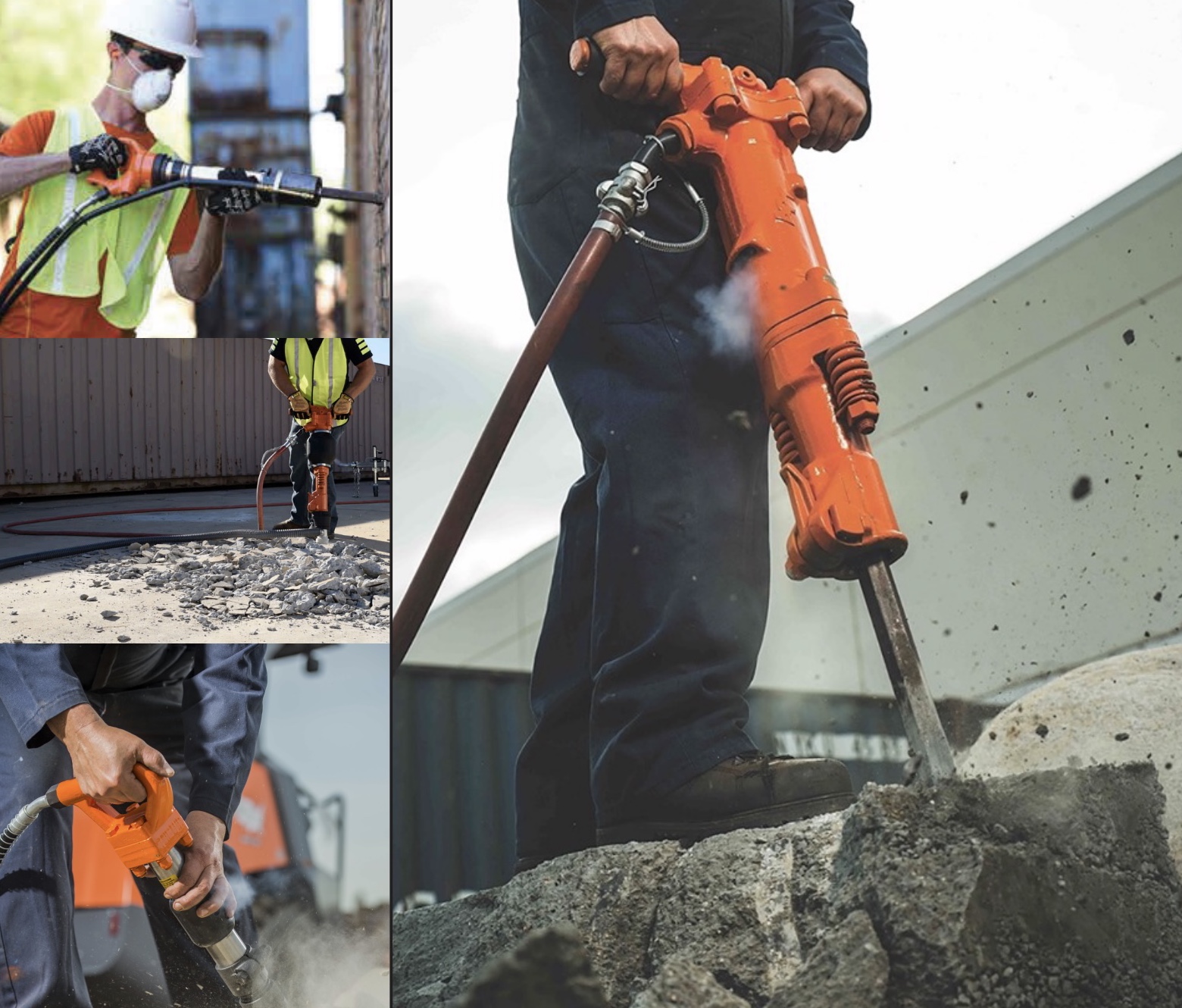
Pneumatic diggers (also known as clay diggers) are versatile and powerful percussive tools designed for digging clay, working with gravel, cutting hardpan, and loosening frozen or compacted earth. They are ideal for trenching, demolition, excavation, brick cutting, asphalt breaking, and light concrete work. Bits are held safely in place by either a latch style or threaded retainer. Diggers are offered with either a T-handle with a lever throttle or rear grip handle with an internal trigger. T handle tools are typically used in an upright position while rear grip diggers are used horizontally or at an angle. Pneumatic diggers are available in a variety of shanks and sizes.
Uses and Applications:
As with most percussive tools, the primary differentiating factor between diggers is their weight. Other factors that set them apart are their stroke length, piston bore, and blows per minute delivered.
Key Features and Benefits:
-
Multiple retainer configurations
-
D-handle grip
-
Extra long nozzles for long life
-
Three-finger inside trigger
-
Excellent power to weight ratio
-
Many models feature built in oilers
-
Wide variety of points, spades, asphalt cutters, and chisels available
Specifications:
-
Available Weights: From 16 Lbs. to 39 Lbs.
-
Blows Per Minute: 1250 to 2000
-
Air Consumption: 35 to 47 CFM
-
Bore (Piston Diameter): 1-11/16” to 1-¾”
-
Stroke Length: 2” to 4-3/8”
-
Available Retainers: Sleeve or latch with latch being the most popular.
-
Nozzle Sizes:
-
¾” Square x 2-¾” Sleeve
-
⅞” x 3-¼” Latch
-
¾” Square x 2-¾” Sleeve
-
1” x 4-¼” Latch
-
Recommended Air Hose Diameter: 1/2”
Backfill Tampers Overview

Backfill Tamper & Sand Rammers are perfect for compacting soil and sand in applications such as packing foundry molds, backfilling foundations, pipework, and cable trenching. Tampers and rammers are built to withstand heavy use and are made with seals designed to keep internal components free from dirt and grit.
Pneumatic backfill tampers (sometimes called powder puffs), are percussive tools designed to compress materials. Think of the term “tamp down,” now extend that to jobs where the need is to create tightly compacted dirt in a recently backfilled hole.
The primary use for a backfill tamper is to compress and stabilize soil around foundation sites, valves, pipes, drains, grates, and other structures. Backfill tampers are used by public works crews, golf course maintenance workers, and on construction sites to backfill trenches.
They are also ideal for foundry, refractory, swimming pools, rammed earth homes, as well as steel drum and mining applications.
How does a backfill tamper work? Backfill tampers utilize a metal or rubber foot (butt) mounted at the end of a reciprocating piston that is used to ram, pound, and tamp down soil, clay or sand. The butts are offered in different shapes and sizes and are taper fit or thread onto the piston of the tool. The larger the tool, the larger the butt and the greater the diameter of the piston rod it is mounted on.
Backfill Tamper Applications:
-
Backfilling holes
-
Firming up cable trenching
-
Providing a stable, firm surface for laying pipes
-
Creating similar surfaces for utility poles, street lights and fire hydrants
Our offering of backfill tampers represent the best in the industry. With hard-hitting power, these long lasting tools ensure dense compaction where support and erosion prevention is the priority. When equipped with rubber tamping butts, backfill tampers, particularly handheld sand rammers, can be used for packing molds in sand cast foundries.
Sand rammer Features:
-
Rugged, time-tested valving
-
Round piston rod
-
Dual-action sand wiper keeps dirt out of the barrel
-
2-1/2” butt standard on handheld bench rammers
-
3” butt standard on upright rammers
Backfill Tamper Features:
-
Built-in lubricator
-
Dual-action sand wiper keeps dirt out of the barrel
-
Plated piston 5-3/4” round malleable butt
-
Flapper valve design allows dirt to pass without clogging the tool
Specifications:
Large Pneumatic Drills Overview
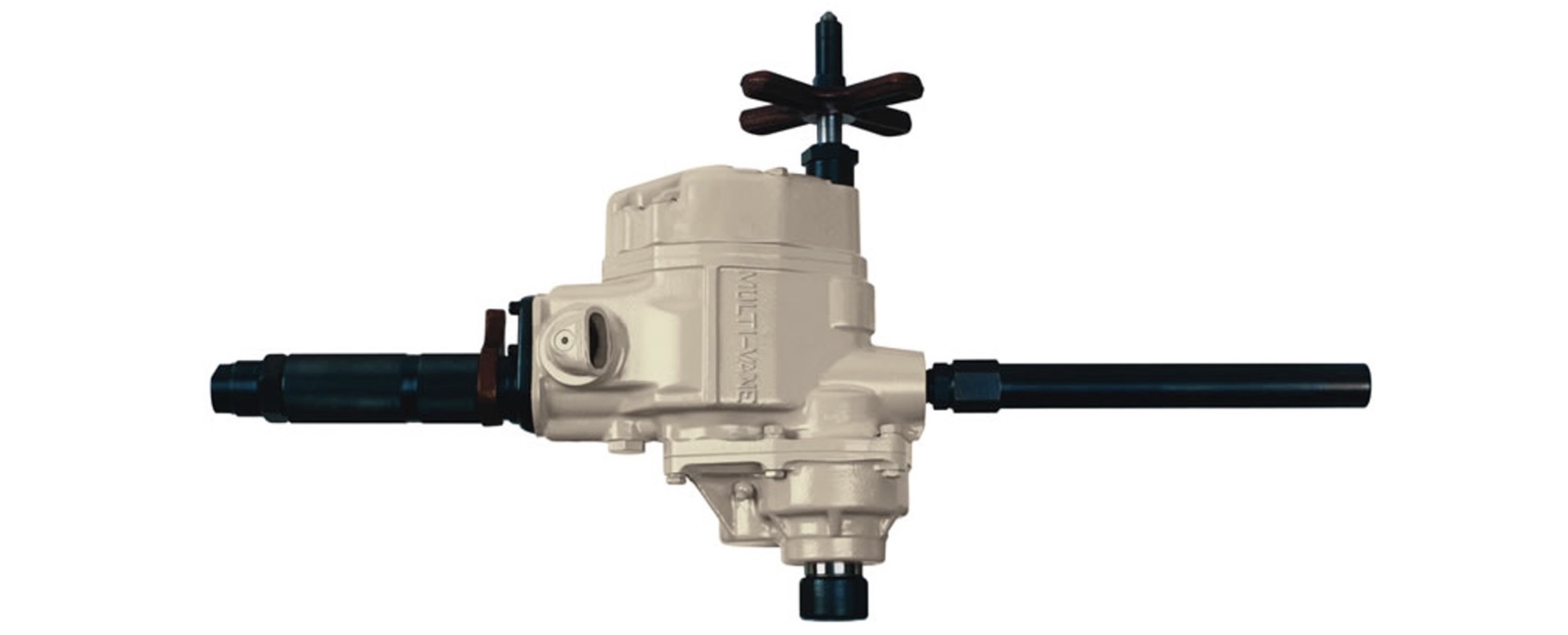
Large Drill motors were originally designed for drilling and reaming holes during the “bolt up” or “hot riveting” processes in steel erection, bridge building, railroad construction, boiler manufacturing, rail car, overhead rail, and shipyards. Steel plates were aligned as close as possible then drilled or reamed to create proper sized holes for bolt, pin, or shaft insertion.
In modern times, aside from drilling, large pneumatic drills are also used for tapping and tube rolling in petrochemical, fabrication, mining, construction, and general industry. They can also be used for opening and closing valves, driving pulleys, and turning gear boxes.
These powerful air drills are lighter and more compact than their electrical counterparts offering superior operator ergonomics with no risk of electrocution. With a powerful 24/7 duty cycle air motor at their core, large pneumatic drills have no switches or brushes to break and replace. In summary, these are very utilitarian tools and can be used for just about any application where a high force, rotary action is required.
-
Strong, lightweight design for fast and ergonomic drilling
-
Ball bearing construction throughout results in both long service life and smooth operation
-
Side exhaust vent to keep exhaust air pointed away from the operator
-
A governed motor regulates air flow to keep the drill working at the peak of its power curve.
-
Integrated lubricator eliminates the need for an external oiler
-
Durable spur gearing
-
Multiple available speeds to match a variety of uses and applications
-
Graduated, self closing, roll throttle for excellent speed control (select models)
-
Independent reverse setting
-
Light, heat-treated aluminum housings for strength without the weight
-
External grease fittings for easy maintenance
Common Applications for Large Construction Drills
-
Wood Boring - Drilling holes in railroad ties, wharfs, and piers
-
Concrete Drilling on Construction Sites - Drilling holes in concrete walls, ceilings, floors to run internet lines, plumbing, HVAC ductwork, sprinkler systems etc.
-
Deep Foundations in Marine and Mining - Drilling cast-in-place piles, lining elements, caissons, etc.
Specifications:
-
Rotational Speed: 77 RPM to 1,025 RPM - The slower the tools have a larger hole drilling capacity, while the faster drills can drill small holes in less time.
-
Capacity: 9/16” up to 3” when drilling, ⅜” up to 2-½” when reaming
-
Spindle / Chuck / Tool Holder: MT2 through MT5, wood boring chucks with set screws, and jacobs chucks (adapters required, call for details)
-
Spindle Attachment: 5/64”-½”, ⅝” Square Drive, ½” Square Drive
-
Horse Power: 1.75” HP up to 5.6 HP
-
Weights: 15 lbs. to 70 lbs.
-
Feed Length: 2.5” to 5” Length of Spindle Travel
-
Height Over Spindle: 16.38” to 21.88”
-
Side to Center Distance: 1.44” to 2.94”
-
Air Consumption: 55 to 160 CFM (Cubic Feet Per Minute)
-
Air Inlet Sizes: ½” to 1”
-
Recommended Air Hose Sizes: ¾” up to 1”
Rivet Busters Overview
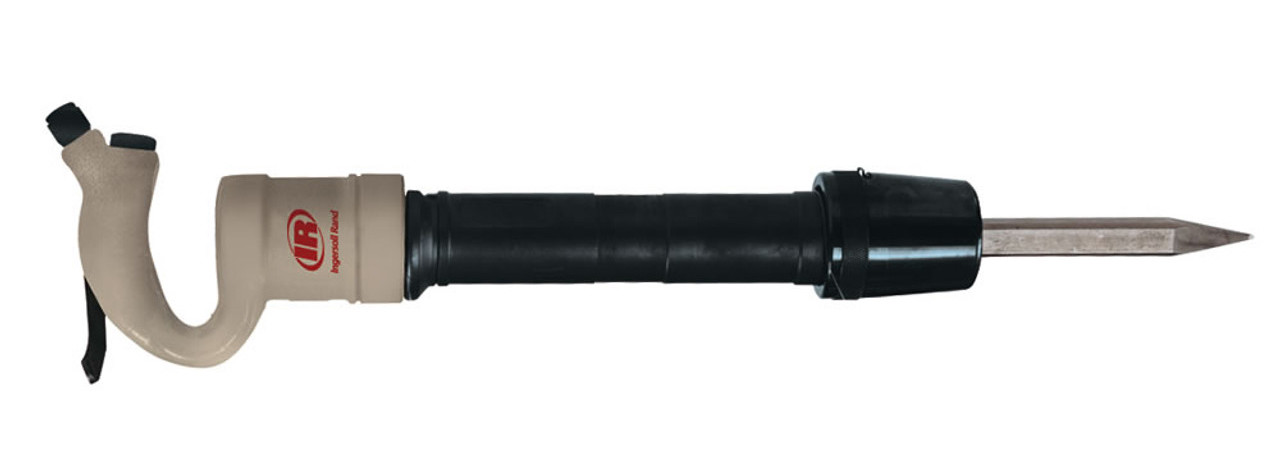
Rivet busters are industrial grade, percussive air tools used primarily for concrete demolition and metal cutting. The name is slightly misleading, as these tools were originally used in the early 20th century to install and remove large rivets from structural steel. With the use of hot rivets in modern building practices virtually obsolete, today, rivet busters are used mainly for demolition.
Smaller than a pavement breaker, but larger and more powerful than a chipping hammer, rivet busters are commonly used on bridge decks, parking garage columns, pillars, refractory and brick, tunnels, and general purpose concrete razing.
In addition to concrete work, rivet busters are also used to remove rusted bolts from machinery and to shear the heads off of large fasteners. They are also used for cutting up metal tanks and dismantling obsolete equipment.
Rivet busters are fairly light tools, but they hit hard and pack a punch. To put it in perspective, a 35-pound rivet buster with an 11-inch stroke can hit with the same amount of force as a 60 pound pavement breaker.
If you can only have room for one percussive tool in your fleet, opt for a 9” stroke rivet buster such as the Ingersoll Rand 9001A.
Key Features and Benefits:
-
Durable enough to withstand repeated drops and use in harsh environments
-
Low blow per minute frequency
-
Teasing throttle levers
-
Steel valves and case hardened cylinders
-
Heavy duty upper and lower sleeves
-
Accept industry standard “jumbo shank” chisels and points
-
Swan neck handle for maneuverability in tight spaces
Key Specifications:
-
Available Stroke Lengths - 8”, 9”, or 11 piston stroke”
-
Piston Bore - 1”
-
Tool Lengths - 22.5” on 8” and 9” models, 24.5” on 11” models
-
Weights
-
8” stroke models weigh 30 lbs.
-
9” stroke models weigh 25 Lbs.
-
11” stroke models weigh 30 lbs.
-
Blows Per Minute (BPM) -800 to 1140 BPM - The longer stroke tools hit slower and harder, while the shorter stroke tools hit faster and lighter.
-
Required Air Flow - 45 Cubic Feet Per Minute (CFM)
-
Air Inlet Size - ½” NPT
-
Air Hose Diameter - ¾”
Note: Rivet busters are commonly used with Jumbo Shank Steels
Maintenance and Care:
The key to getting the most from your air tools is operating them with clean, dry, and well lubricated air. As with a car, all pneumatic tools require clean oil to function properly. The use of a filter-regulator-lubricator device mounted on the outlet pipe of your air compressor is highly recommended. At a minimum, an inline oiler should be used with all the tools mentioned in this guide unless the tool has an integral lubricator.
Due to the percussive nature of construction tools and the environments in which they operate, eventually your tools will need replacement parts. A quick review of any parts manuals will reveal a list of suggested tune up kits and wear parts to stock in order to keep your fleet of tools performing optimally.
International Air Tool Co offers repair parts for all major brands of pneumatic tools. Stock up on extra retainers, sleeves, springs, bumpers, hose whips, and other wear parts in order to avoid downtime in the field.
Conclusion:
The preceding guide has provided an overview of the most popular pneumatic construction tools found on jobsites today. With the exception of large drills, all the tools discussed are percussive in nature. The primary differentiators between the tools discussed are their physical size and the degree of force with which they hit. As a general rule of thumb, you should select the smallest tool that will accomplish the task at hand. The reasoning behind this rule is to place as little physical strain on the operators as possible.
While some tools in this guide may be used interchangeably such as a small rivet buster and a large chipping hammer, others, like large pneumatic drills, are unique in form and function.
Need help selecting the right tool for the job in front of you? We are here to help. Since 2011, we have helped thousands of contractors and manufacturers to maximize the productivity they derive from their air tools, thus contributing to greater output and higher profits.
For application support by phone please call (442) 515-3765 or if you prefer to write, our email address is info@intlairtool.com. We look forward to working with you.
|

